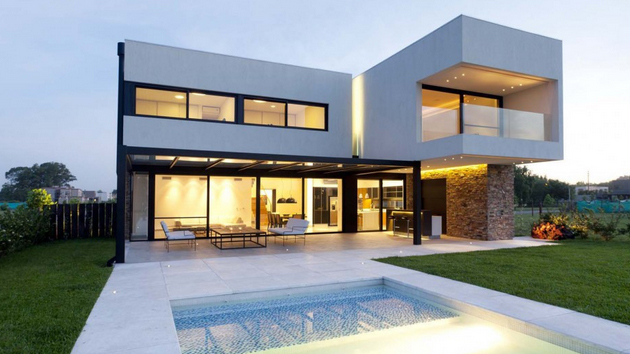A style to replace the International Style. Jet travel was more common after WWII, making style and design easier to share among countries. Also, increased speed of communication occurred, taking place through magazines, books, and the television.
Contemporary Design: Hi-Tech
New technology was one of the prime basis of modern design. Modern materials such as glass, concrete, and steel were being incorporated in design. The popular term given to design based on advanced technology is Hi-Tech. More than 50% of the cost of any modern project is generated by the systems provided: electrical, plumbing, telephone, and air quality services. This design type rejects the ideas of modernism and reflects the designs of early modern concepts.
Contemporary Design: Deconstructivism
This was a term that came to use to identify a design practice that emerged in the 1980'2 and 1990's. The word literally means to be broken up, loosely assembled parts and elements that were seemingly torn apart and reassembled in chaos.
Design Here and Now "Going Green"
The USGBC developed Leadership in Energy and Environmental Design. This green building rating system was design to provide effort to national standard for what constitutes a "green building", and also developed to help design teams and owners determine green project goals, identify green design strategies, and monitor/document project success. There are six overall sections of LEED: sustainable sites, water efficiency, energy and atmosphere, materials and resources, indoor environmental quality, and innovation and design process.
Moving forward, there was many influential architects in these time periods. One of my favorite architects from this time was a man named Cesar Pelli. He was an Argentine/American architect that designed some of the worlds tallest buildings. He built the Petronas Center in Malaysia.
The next architect that I really favored from this time was Richard Buckminister Fuller. He was an American engineer, designer, inventor , and philosopher. However, much of his work ended after the few prototypes that he could produce. He used a lot of geometric concepts by constructing hemispherical dome structures from triangular units. His most famous design that displayed this concept was the U.S. exhibit pavilion at Expo 67.
The final architect who's style I loved during this time was Norman Foster. He had a partnership with Richard Rogers from 1963-1965. He also, designed with Willis, Faber, and Dumas. His most famous architecture that I liked the most was the Gherkin in London.
Some modern applications from this time would be a modern version of the Chippendale Chair constructed and designed by Robert Venturi and Densie Scott Brown.
Another modern application would be this modern contemporary designed home, using very futuristic style.
I reviewed Samantha's blog and she used some great examples of the contemporary design in the pictures she displayed of the architects
I reviewed Allison's blog and she had a great example of the Guggeliem Museum that showed contemporary design to a tee.
Here is my youtube clip of Cesar Pelli's Petronas Center design: https://www.youtube.com/watch?v=_0i3c5vYgpU






